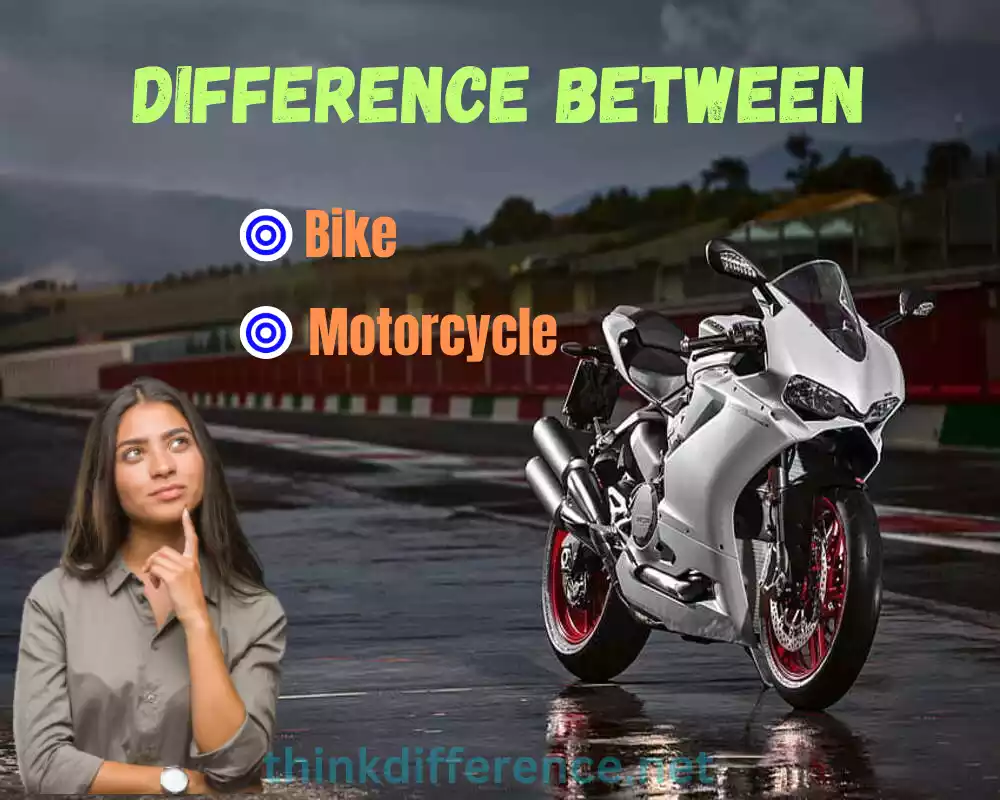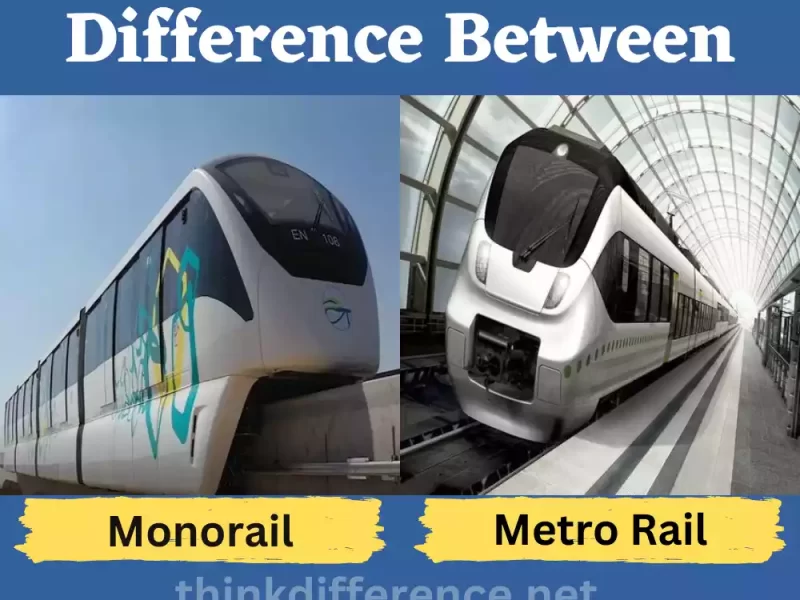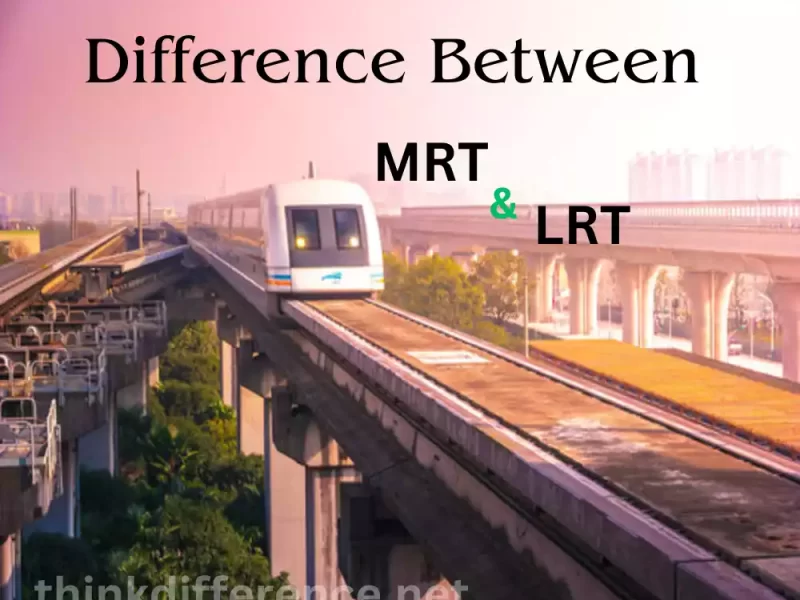Explanation of Bike and Motorcycle
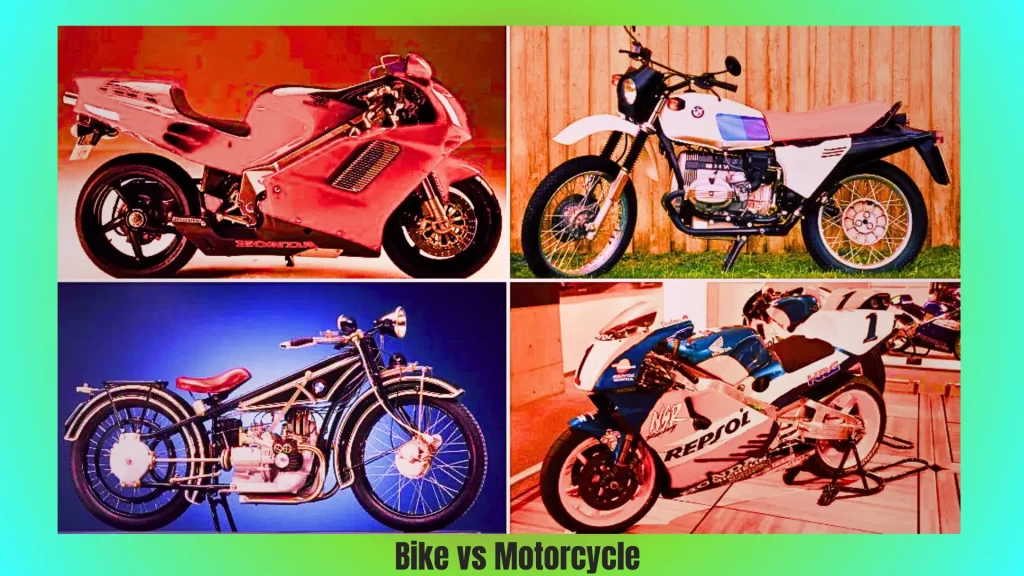
Bike:
Bikes are human-powered vehicles with two wheels connected by an axle frame and pedals for propulsion by humans. Riders push these pedals in circular motion to propel forward progress on the bike’s rider’s part and propel the ride forwards.
Bicycles come in various types such as road bikes, hybrids, mountain bikes and city bikes to meet different riding styles or purposes such as short distance commuting or exercising needs. Lightweight materials like aluminum or carbon fibre help make these lighter-weight so maneuverability improves when it comes to maneuverability/weight balance while improving maneuverability/weight characteristics when making bikes for shorter range and better maneuverability on roads than motorcycles do due to zero emissions emissions while riders face more risks on roadways while using one!
Motorcycle:
Motorbikes, unlike bicycles are two-wheeled motorized vehicles powered by engines rather than human muscle power. There are various kinds of motorcycles on the market today including cruisers/standard/street bikes and sport bikes that you can purchase today. Electric motorcycles typically feature frames crafted of heavy materials with strong frames to allow for higher speeds and are powered by electric motors or internal combustion engines; manual transmission is the norm but automatic options can also be made available.
Motorcycles serve many functions in modern society including transportation, recreation and sport. Their fast acceleration enables riders to travel greater distances more quickly. Motorcycles require special licensing and training due to the increased risks they entail compared with bicycles, with riders wearing protective equipment including jackets and helmets for safety purposes. Insurance and maintenance costs also arise for this form of transport, their environmental impacts vary depending on type; internal combustion engines produce pollutants while electric motorbikes emit zero emissions.
Bikes are propelled by human power and used for exercise, recreation and short distance commuting primarily. Bikes are generally affordable and environmentally friendly. Motorcycles are motorized vehicles used for sport, recreation and transportation and typically require training as well as safety gear; their costs tend to be greater as does their impact depending on engine type.
Importance of bikes and motorcycles in transportation
Bikes and motorcycles both play important roles in transportation; each serving their own set of purposes with distinct advantages. Here are a few reasons that both bikes and motorcycles play such an integral part:
- Efficient Urban Mobility: Bikes and motorcycles make efficient urban modes of transport in congested urban environments, being able to navigate traffic with ease while taking advantage of small spaces. Bikes offer faster travel times during peak hours – ideal for short commuters as riders can quickly negotiate through congested streets to their destinations faster.
- Cost-Effective Transportation: Bikes and Motorcycles can be more cost-effective alternatives to cars or public transportation due to lower upfront costs, reduced maintenance expenses and minimal expenses such as fuel or fare payments. As they remain an accessible and feasible transportation choice for many, this makes bikes/motocycles especially beneficial in places where owning one might prove challenging.
- Reducing Congestion and Parking Issues: By opting for bike travel over vehicle travel, people can help alleviate congestion issues in urban areas with limited parking spots. Bikes take up minimal space when it comes to parking; making this mode of transport an efficient means of moving people. This also improves traffic flow for greater system efficiencies.
- Environmentalism: Electric motorcycles and bikes have less of an environmental impact than cars or other motor vehicles, especially bikes that produce no emissions. Electric-powered motorcycles also reduce greenhouse gas emissions and pollution in the air compared with engines powered by internal combustion technology; contributing towards creating a cleaner environment by choosing them can make an individual part of an effort towards greater sustainability and cleaner environments.
- Benefits to Health and Wellbeing: Both cycling and motorcycle riding promote physical fitness and well-being, especially through cardiovascular benefits, enhanced muscular endurance/strength gains, weight control benefits and body-shaping effects. Biking/motorcycle riding offers enjoyment while at the same time improving mental wellbeing, physical wellbeing and quality of life.
- Last-mile connectivity: Motorcycles and bikes provide ideal last-mile connections between transportation hubs and destinations, offering individuals quick, effortless transport over short distances while increasing efficiency and accessibility of transportation networks.
- Flexible and Versatility: Bikes, motorcycles and other vehicles offer flexibility and versatility when it comes to transportation needs. From urban streets and trails to rural terrain they provide transport flexibility across a range of terrain. There is an assortment of motorcycles and bikes on offer so individuals can select one best suited to meet their transportation requirements.
Bikes and motorcycles have quickly become an attractive mode of transport due to their affordability, efficiency, environmental sustainability and health advantages. Bicycles and motorcycles reduce traffic congestion while offering accessible transport solutions in different settings; providing individuals with accessible transport alternatives in any situation and contributing to creating a seamless transportation network that’s both interconnected and sustainable.
What is Bike?
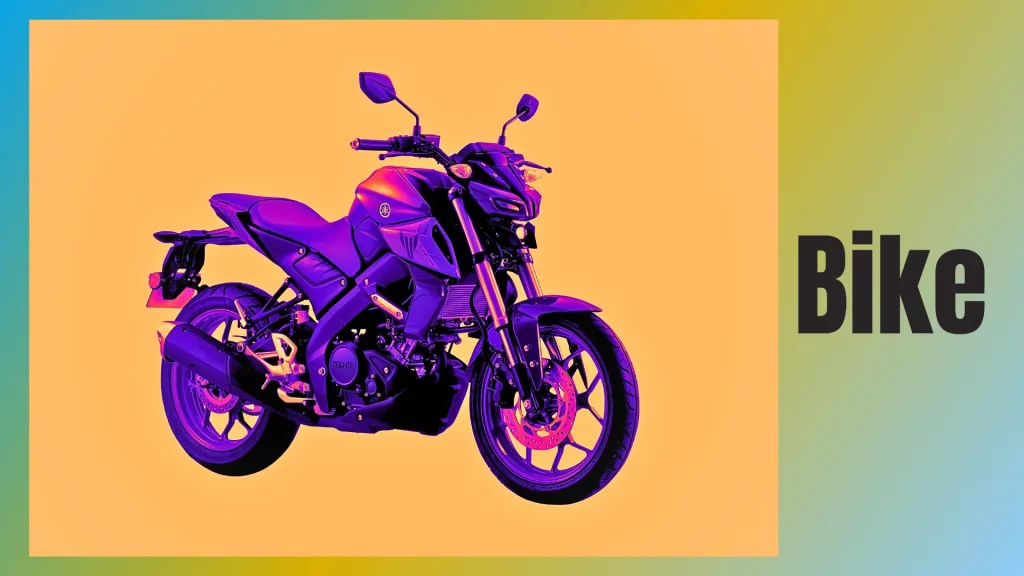
Bikes are two-wheeled human-powered vehicles propelled by pedaling. Composed of two wheels connected by pedals and chain links, bikes come in many designs including road bikes and mountain bikes – not forgetting hybrid bikes for city rides as well as hybrid and city bikes that specialize in specific terrain conditions and purposes.
Bikes can be utilized for numerous activities including sports, exercise, recreation and commuting. As bikes do not consume fuel or emit any emissions they provide a low-carbon form of transport while simultaneously improving health, promoting physical fitness and decreasing congestion on roadways.
Bicycles have come a long way since their invention, adapting with technological, material, and design advances over time. Bikes offer unparalleled customization capabilities; individuals can select their perfect bicycle from among various frame sizes, gear ratios, suspension types and accessories that improve comfort, performance or utility features.
Bike sharing systems have become integral parts of city transportation systems in many cities around the globe, while infrastructure such as dedicated bike lanes promote their use. Bikes offer commuters convenient transport solutions while leisure riders and sports competitors use them for leisure or competition; providing both recreation and transport opportunities to people of any age and ability.
What is Motorcycle?
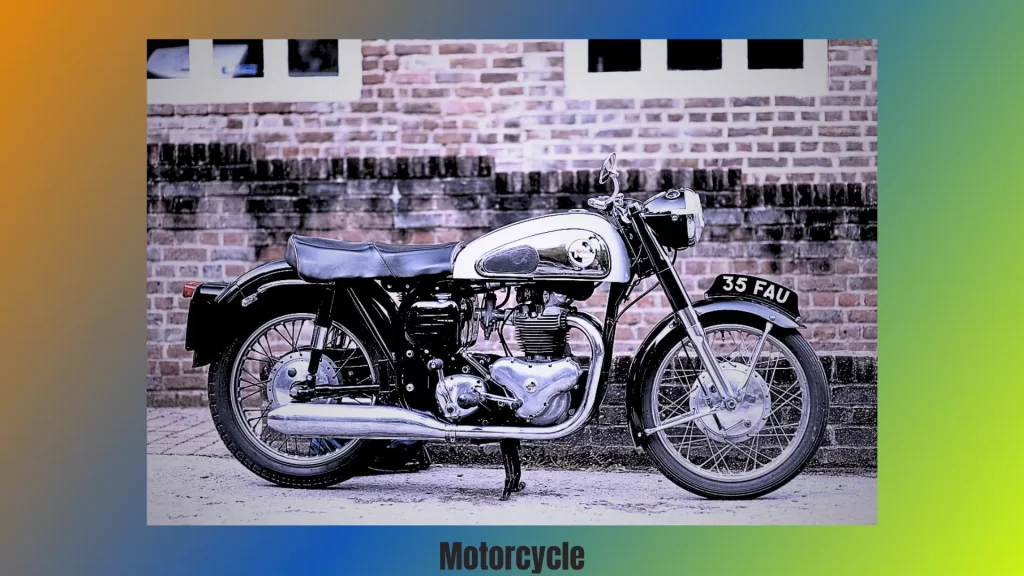
Motorcycles are two-wheeled motorized vehicles powered by internal combustion engines. Their primary function is personal transportation. A motorcycle’s main components include its frame, engine two wheels and handlebars.
Motorcycles are faster and boast greater power than bicycles, offering unique styles such as sport bikes, cruisers and touring bikes for touring as well as off-road bikes with different designs to meet individual preferences and specialized riding environments.
Motorcycle engines convert fuel into mechanical energy that propels a motorcycle forward. Most bikes run on gasoline fuel, although battery powered electric motorcycles have become increasingly common over time.
Motorcycles offer riders a convenient means of transport that enables them to cover greater distances faster than automobiles or bicycles. Riders use motorcycles for various purposes including commuting to work, touring, recreation riding, racing and much more.
Safety should always be at the forefront when riding a motorbike and riders must obtain and follow specific regulations and licensing. Protective gear such as helmets, gloves and jackets is recommended to enhance rider protection and enhance riding enjoyment.
Motorcycles differ considerably in their fuel economy, emissions and environmental impact depending on factors like engine size and compliance with emission regulations. Electric motorcycles offer an environmentally-friendly solution.
Motorcycles offer an ideal form of travel for people who enjoy the rush and adrenaline of two wheeler riding, with various styles and features available depending on personal taste and purpose.
Design and Size
Bikes and motorcycles feature different designs and sizes that create distinct characteristics and uses for each of them. Here are some main differences between them in terms of design and size:
Frame and Body Structure:
- Bikes: Bikes have frames made out of lightweight materials such as aluminum or carbon fibre for increased maneuverability and efficiency. Their frames tend to be lightweight yet rigid for enhanced efficiency in maneuvering around obstacles or roads.
- Motorcycles: Motorcycle frames tend to be stronger and made from heavier materials like steel or aluminum alloy, providing structural support and strength for engine, transmission and other components of a bike’s structure.
Dimensions:
- Bikes: Bikes are smaller and easier to maneuver than motorcycles in various environments such as busy streets, bike lanes and trails.
- Motorcycles: Motorcycles have grown considerably more spacious and cumbersome over time. Motorcycles feature larger dimensions, longer wheelbases and higher seat heights. Their increased size allows a larger engine, larger fuel tanks, as well as other components designed to increase comfort and performance.
Weight:
- Bikes: Bikes are lightweight vehicles. Most models typically weigh anywhere between 6 pounds to 30 pounds (6 kilograms to 13 kilograms), making them easier to pedal and maneuver thanks to their light construction.
- Motorcycles: Motorcycles weigh significantly more than bicycles due to larger engines, extra components and structural reinforcements that increase their weight. Weight can range anywhere from 100 kilograms up to 500 kilograms depending on size/type; which limits riders from riding one.
Seating Configuration:
- Bikes: Bike generally feature one seat that can comfortably fit one rider; some models provide multiple seating arrangements (for instance tandem bikes and cargo bikes can hold multiple riders or cargo).
- Motorcycles: Motorcycles are usually constructed to seat one or two individuals at once. Most have either a rider’s seat and either footpegs or seats for passengers; longer trips might call for adventure bikes that have more spacious seating arrangements.
Body Style:
- Bikes: Bicycles are open and simple vehicles with limited bodywork; most attention is focused on their frame, wheels and functional components such as brakes. Certain kinds of bikes such as recumbent and specialty models may feature unique body designs to meet specific purposes.
- Motorcycles: Motorcycle body styles differ depending on their intended use and aesthetic appeal, such as standard/street bikes (also referred to as street bikes), cruisers, sports bikes, adventure bikes or touring bikes. Each body style provides various features and comfort ratings in its ride experience and aerodynamic properties.
Motorcycles and bicycles reflect their respective uses and purposes in their design and size, such as for commuter and recreational riding respectively. Bikes tend to prioritize simplicity, agility, lightweight construction and simplicity when it comes to commuter biking; in contrast to motorcycles that focus more on comfort, power and performance as part of sport or adventure riding experiences.
Engine and Power
Motorcycles and bikes each possess unique propulsion systems, power sources and other features which set them apart. Here are a few main differences in terms of engine power and propulsion systems between them:
Bikes
- Bikes are driven by human power alone: When pedaled by its rider, muscular energy converts into rotational forces which propel wheels forward through gears, chains and sprockets that amplifies its force to enable cycling forwards.
- No Motor: Bicycles do not depend on an internal combustion engine for power; rather, their rider acts as their sole source of propulsion, making cycling an emission-free mode of transport.
- Limited Speed and Power: Bikes have limited power and speed due to being human-powered vehicles; their maximum speed depends on both rider fitness levels and gearing choices for maximum acceleration. Bikes tend to travel slower with lower top speeds compared to motorcycles.
Motorcycles
- Engine-Powered Propulsion: Motorcycles feature engines which serve as primary propulsion. Transmission systems transfer this power and torque directly from engine to wheels for propulsion; riders use throttle controls to regulate both output and speed from engines.
- Various Engine Types: Motorcycles come equipped with various engine types, such as internal combustion engines (ICEs) and electric motors. Internal combustion engines generate power via controlled explosions fueled by gasoline or another form of fuel while electric motorcycles use energy stored from batteries as their source.
- Higher Speed and Power: Motorcycles are considerably faster and more powerful than bicycles. Thanks to their engines’ output, motorcycles can accelerate more rapidly and reach higher speeds than bikes can; their top speeds and acceleration capabilities vary according to factors like engine size, design features and intended use.
- Engine Size and Performance: Motorcycle engines come in all sorts of shapes, sizes and performance levels. Engine displacement measures the volume of combustion chambers using cubic centimeters or liters as its measurement system; motorcycles typically use smaller displacement engines designed for urban commutes or leisure riding purposes while larger displacement motors provide sportier rides and increased performance levels.
- Emissions: Internal combustion engines produce exhaust emissions by burning fossil fuels, contributing to air pollution and greenhouse gases. Electric motorcycles do not emit tailpipe emissions making them an environmentally-friendly alternative.
Motorcycles and bicycles differ considerably when it comes to power source. Motorcycles rely on internal combustion engines with electric motors for propulsion while bikes rely on pedaling power alone. Motorcycles tend to offer faster speeds, greater power outputs and a wider variety of performance levels than their bicycle counterparts.
Speed and Performance
Speed and performance differences between bikes and motorcycles are significant, as can be seen below in a comparison between them.
Bikes
- Speed: Bicycles tend to travel at slower speeds than motorcycles; their maximum speeds depend on various factors including rider, gearing system and terrain. On flat roads experienced cyclists may reach 15 to 20 mph (24 to 33 kilometers per hour); professional cyclists often attain even faster speeds.
- Acceleration: Due to being powered solely by human energy, bikes accelerate more slowly than motorcycles; riders must exert effort in order to gain speed. Modern road bikes with lightweight frames and efficient gear systems tend to accelerate more rapidly than heavier or casual bicycles.
- Performance Variations: Bikes come in all sorts of designs and performance characteristics; mountain bikes feature improved suspension and maneuverability for off-road trails while road bikes were built specifically to handle speed on pavement surfaces. City bikes or hybrid bicycles offer the ideal blend between speed and comfort when used for urban commutes.
Motorcycles
- Speed: Motorcycles reach much higher speeds than bicycles; their top speeds depend on factors like engine size, weight and design; sport bikes designed for high performance riding can reach 150 miles per hour (244 kilometers per hour). Even lower top speed motorcycles still make for faster rides than bikes.
- Acceleration: Their powerful engines and lightweight frames, motorcycles accelerate much more rapidly than bikes. Motorcyles can quickly accelerate due to torque and horsepower produced by their engines; reaching higher speeds quickly in no time at all. Sport bikes benefit from aerodynamic and lightweight designs for rapid acceleration as well.
- Performance Differences: Motorcycles come in all different kinds and each model comes equipped with its own set of distinct performances. Sport bikes have advanced suspension systems and aerodynamic fairings designed for high-speed performance; cruisers offer greater comfort with larger engines that enable relaxed riding; adventure bikes offer long distance and off road travel capabilities; each type has distinctive performance traits which adapt specifically to its intended use.
Motorcycles and bicycles require safe and responsible riding to be navigated responsibly and within legal boundaries, taking into consideration road conditions. Adhere to traffic laws as you prioritize both your own and others’ safety when riding these machines.
Licensing and Regulations
Licensing requirements and regulations for motorcycles vary by region or country, Here is an overview of some typical licensing requirements:
Bikes
- Licensing: Bicycles do not typically require a license in most jurisdictions. Because non-motorized bicycles do not need special permission for riding, anyone of any age may do so without needing a special permit or special permission from authorities.
- Age Restrictions: Bikes don’t typically limit children by their ages. New riders can learn under parental supervision before gradually building the confidence and skills necessary for independent riding.
- Bicycle Traffic: Regulations bicycles must abide by the same traffic rules as motorized vehicles, including obeying traffic signals, stopping at stop signs and yielding to pedestrians.
- Safety Equipment: Although helmets aren’t legally mandatory for all cyclists, especially children. Helmet laws may differ depending on jurisdiction or age groups.
Motorcycles
- Licensing: To operate a motorcycle legally and responsibly, a special license is necessary. While licensing requirements differ by jurisdiction, typically written and practical examinations will need to be passed in order to obtain one.
- Age Restrictions: When applying for a motorcycle license there are age requirements; minimum restrictions vary by jurisdiction but typically fall between 16-18 years of age. New riders may also face restrictions regarding engine size or power output restrictions when making this step.
- Registration and Insurance: Motorcycle owners are required to insure and register their bikes with an appropriate government agency, with specific registration and insurance requirements applicable in their local jurisdictions. Failure to abide by such requirements could incur fines or penalties from local authorities.
- Traffic Regulations: Motorbikes fall under all of the same laws that other motorized vehicles do, including speed limits, traffic signs and signals, using designated lanes and yielding to pedestrians. Riders should also abide by any special requirements regarding lane splitting, helmet use and visibility-enhancing gear.
- Safety Equipment: Most jurisdictions mandate motorcycle riders wear safety gear such as helmets. Depending on local regulations, riders may also be required to wear other protective apparel like jackets, gloves and boots for optimal riding safety.
To ensure the safe operation of motorcycles and bikes legally and safely, it’s vitally important that riders are informed about all relevant licensing and regulation requirements within their local jurisdictions. Motor vehicle or transportation agencies are an invaluable source of information regarding registration requirements applicable to bikes or motorcycles.
Purpose and Usage
Bikes and motorcycles serve various functions and purposes, Here is an overview of these vehicles’ usage:
Bikes
- Recreation and Exercise: Bicycles provide both exercise and recreation; from leisure rides and cycling tours to exploring natural landscapes or simply for leisure use. Biking has long been recognized as an efficient cardiovascular fitness promoter.
- Commuting and Urban Transport: Bikes have quickly become an environmentally-friendly mode of urban transport, offering riders a quick way to access public transit without dealing with parking hassles or traffic jams while enjoying all the health advantages that active transportation brings with it.
- Sports and Competitions: Bikes can be utilized for sports and competitions such as road cycling and mountain biking, using specially constructed bikes tailored for specific terrains or performance requirements, to offer athletes and enthusiasts competitive opportunities.
- Delivery and Cargo: Bicycles equipped with cargo racks or trailers are increasingly being utilized as last mile delivery solutions for goods, packages, food etc. in urban environments. Delivery cyclists provide efficient yet eco-friendly last-mile solutions.
- Tourism and Sightseeing: Bikes are popular tools for touring tourist attractions and sightseeing, making bike tours the ideal way to see cities, parks and scenic areas at your own leisure. Bike tours allow riders to fully appreciate both scenery and culture at their own leisurely pace.
Motorcycles
- Personal Transportation: Motorcycles have long been considered an efficient form of personal transportation. Motorcycles offer flexible yet efficient commuting solutions in areas with heavy traffic congestion; in certain circumstances they offer faster travel with greater maneuverability and flexibility compared to cars.
- Sports and Recreation: Motorbikes have long been used in recreational settings as an enjoyable means of exploring nature or riding off-road, providing thrilling experiences where riders can test the speed, handling, performance and handling capabilities of motorcycles over controlled surfaces or natural landscapes.
- Long Distance Riding: Touring bikes and adventure motorcycles are ideal vehicles for long distance riding, offering features designed to increase comfort, storage capacity and endurance – perfect for road trips! They allow riders to discover long distances across vast territories while remaining comfortably situated behind the handlebars.
- Commercial and Professional Use: Motorcycles can be utilized for both professional and commercial applications such as courier services, food deliveries, law enforcement patrols and the transport of professionals like paramedics or security staff. Their agility makes them perfect for this use in congested areas.
- Motorcycle clubs and groups: Riding motorcycles is an enjoyable social pastime, leading enthusiasts to create clubs and groups dedicated to this activity. Members participate in group rides and rallies as well as charity events and social gatherings with each other while creating bonds among fellow motorcyclists. These communities foster camaraderie among motorcycling enthusiasts.
Motorcycles serve a multitude of uses, ranging from personal transportation and sports/adventure/professional requirements to leisure rides for personal enjoyment or adventure and professional needs. Riders of motorcycles/bikes enjoy many advantages that help them select their optimal mode of transport for themselves and their needs and preferences.
Safety Considerations
Both bikes and motorcycles present significant safety hazards, here are a few safety tips for both:
Bikes
- Helmet Use: Helmet use by all bike riders is absolutely vital, as helmets provide essential head protection during collisions or falls, helping lower injuries by up to 30% and helping prevent additional ones occurring due to falling objects or impact. When looking for one that meets safety standards and fits correctly.
- Visibility: Visibility is paramount when it comes to bike safety. Increase visibility through reflective clothing, reflectors and lights by donning reflective pieces such as clothing with bright hues that reflect light back onto you from nearby sources like streetlamps or lights at night – particularly low light conditions where motorists might not spot you easily!
- Traffic Awareness: Bicyclists must remain aware of traffic rules and their surroundings while pedaling. Obeying traffic signals, giving pedestrians priority, signalling turns appropriately, using designated bike lanes or paths can all help minimize collisions with other vehicles. Being predictable and alert may reduce collision risks altogether.
- Proper Maintenance: Preserving the safety of your bike requires regular inspection, with particular focus placed upon checking tire pressure, brakes and chain as well as any other component parts which could contribute to mechanical failure and cause accidents. Ensuring its working order as quickly as possible and making any needed repairs as soon as they arise are also key aspects.
- Defenseless Riding: For maximum safety when riding, defensive riding techniques should be practiced regularly to avoid accidents and stay alert at intersections. Anticipate potential dangers by keeping an appropriate distance between vehicles and being careful at intersections; furthermore it’s vital that one remains focused and avoid distractions whilst riding.
Motorcycles
- Protective Gear: Riders should always wear protective clothing such as jackets and pants when riding motorcycles, along with helmets approved by the Department of Transport (DOT), eye protection devices, and sturdy footwear to reduce risks related to collisions and reduce serious injury risks. Such gear provides extra safety during an incident while helping minimize serious consequences from occurring.
- Skills and Training: It is imperative that riders develop riding skills and receive appropriate training to maximize motorcycle safety. A motorcycle safety course provides riders with essential techniques, defensive strategies, and emergency maneuvers – and all riders should continue honing these abilities and honing their practice!
- Defensive Riding: Motorcycle riders need to practice defensive riding to anticipate potential dangers and react swiftly when encountered. A safe distance behind vehicles should be maintained, blind spots identified and constant road scanning performed to reduce risks associated with an accident. Being predictable and cautious while out riding can significantly lessen risks of an incident occurring.
- Visibility and Communication: Visibility is of vital importance when riding motorcycles. Utilizing headlights and reflective or brightly-colored gear helps other drivers recognize and anticipate the movements of its rider. Utilizing hand signals or maintaining proper lane positioning as necessary facilitates clear communication among road users and aids smooth rider navigation.
- Regular Maintenance: Regular Maintenance is critical to motorcycle safety. By checking tire pressure, brakes, lights and other components regularly for potential mechanical issues you can quickly identify any mechanical concerns with your machine. Furthermore, keeping its chain suspension tires properly aligned for safe handling and performance are integral aspects of safe ownership and use of any motorcycle.
Motorcyclists and bikers should prioritize safety first when riding. Motorists and bikers alike should follow traffic laws and stay aware of their environment to increase overall riding safety. Staying sober, minimizing distractions (like cell phones) and obeying speed limits is also crucial to creating safer riding experiences on the road. Safety comes from continuing education about limitations as well as respect between road users.
Cost and Affordability
Cost and affordability should always be taken into consideration when making decisions about motorcycles and bikes, so here is an outline of each type’s costs:
Bikes
- Initial Cost: Bicycles tend to be less costly than motorcycles in terms of initial costs; their prices depend on factors like brand name and features available as well as quality considerations. Entry level bikes used for commuter or recreational purposes typically fall between moderately and affordably priced ranges making them accessible across a range of budgets.
- Maintain and Repairs: Bikes require less upkeep and repair costs than motorcycles, with easier components for riders to maintain themselves and basic tools available to perform regular tasks such as lubricating chains, checking tire pressure and adjusting brakes.
- Fuel and Operating Costs: Bikes don’t require fuel for transportation purposes and therefore represent great cost efficiency. Their primary expenses come in replacing consumable items like brake pads, tires and chains – although repairs or upgrades may arise. Though, owning and using one should remain quite cost effective.
Motorcycles
- Initial Cost: Motorcycles typically are more costly than bicycles and their pricing depends on features, brand, engine size and model; motorcycles designed specifically for high performance or sport riding tend to command a premium over those meant for entry level use or commuter use.
- Maintenance and Repairs: Motorcycles require more frequent and costly, maintenance than bikes do, which typically requires professional expertise as well as special tools and specialized equipment for regular tasks such as oil changes, brake repair services and periodic inspections. Due to complex motorcycle systems and engines this can increase costs significantly over time.
- Fuel and Operating Costs: Motorcycles require fuel for operation; costs vary based on engine size, efficiency and riding style. While motorcycles tend to be more fuel-efficient than cars in terms of travel or commute times, its total operating cost must also include this expense.
- Insurance: Motorcycle insurance costs should always be an important part of a rider’s overall financial planning strategy. Costs depend on various variables such as their age and experience riding motorcycles, location, type of bike owned and any coverage options purchased – usually bike insurance is more costly due to motorized risks involved than their motorcycle counterpart.
The costs listed above should only serve as an approximate guideline; your actual ownership and operating costs for a motorcycle or bike depend on your individual circumstances, local market factors and personal preferences. Considerations must also be given to financing options available as well as secondhand or used purchases as well as maintenance services available that could have an impactful financial effect.
Environmental Impact
Due to their various modes of propulsion, bikes and motorcycles each have unique environmental impacts that differ considerably. Below is an overview of this impact:
Bikes
- Green and Sustainable: Bikes are an environmentally-friendly transport option. No emissions or air pollution is produced when using human power for propulsion – making bikes an eco-friendly transport method suitable for urban transportation, short distance commuting or recreation purposes.
- Energy Efficiency: Bikes are highly efficient modes of transportation; converting human power directly into mechanical energy without additional fuel requirements or resource usage. As an environmentally responsible choice of transport they require minimal resources.
- Reduced Carbon Footprint: Bikes help mitigate climate change and lower greenhouse gas emissions by choosing bicycles over motorized vehicles when making short journeys. Bicycles reduce traffic on roads and require fewer parking spots – giving individuals another tool in fighting greenhouse gases emissions and global warming.
- Sustainable Infrastructure: Biking promotes sustainable infrastructure. Building bike lanes, cycling paths and bike-friendly infrastructure increases active transport while supporting an eco-friendly urban environment. By investing in biking infrastructure locally communities can make cycling safer and simpler than ever.
Motorcycles
- Emissions and Air Pollution: Motorcycles contribute significantly to air pollution by emitting greenhouse gases and other forms of air pollutants into the atmosphere, such as carbon dioxide (CO2) and nitrogen oxides from their internal combustion engines releasing into the environment. Emission levels depend upon engine size, technology and compliance with emission regulations imposed upon motorcycle manufacturers.
- Fuel Efficiency: Motorcycle fuel efficiency depends upon engine size, design and riding style. Motorcycles tend to be more fuel-efficient than cars – they consume lower amounts per kilometer of gas while emitting less carbon dioxide emissions. Some high-performance models consume more gas and produce more pollutants than smaller and less inefficient motorcycles.
- Noise Pollution: Motorcycles can be a source of noise pollution, particularly if their riders alter the exhaust system to increase noise output or operate them in ways that create excessively loud sounds. Noise pollution has serious repercussions for both people and environments alike – particularly within residential communities or natural habitats.
- Evolving Technologies: Electric motorcycles and hybrid bikes are currently being developed to minimize their environmental impacts, in an attempt to lessen motorized two-wheeler use. Electric motorbikes emit no tailpipe emissions, can use renewable sources of power, and reduce carbon footprint footprint further by developing their technology and infrastructure further.
Bicycles and motorcycles both contribute to sustainable transport while mitigating environmental impacts, with fuel-efficient motorcycles, cycling infrastructure support, responsible riding practices and increased education all playing their parts to minimize environmental footprint.
Comparison table of Bike and Motorcycle
This table highlights key distinctions between motorcycles and bicycles:
| Features | Bike | Motorcycle |
|---|---|---|
| Propulsion | Human power | Internal combustion engine |
| Size and Design | Smaller and lighter | Larger and heavier |
| Maximum Speed | Generally lower | Higher |
| Performance | Lower power and acceleration | Higher power and acceleration |
| Licensing and Insurance | Usually not required | Licensing and insurance required |
| Fuel Consumption | None (human-powered) | Fuel consumption varies based on engine size |
| Emissions | No emissions | Carbon emissions and air pollutants from exhaust |
| Cost | Generally lower initial cost and maintenance | Higher initial cost and maintenance |
| Purpose and Usage | Recreation, commuting, sports, delivery, tourism | Personal transportation, recreation, touring |
| Environmental Impact | Environmentally friendly, no emissions | Emissions contribute to air and noise pollution |
| Safety Considerations | Helmet use, visibility, traffic awareness | Protective gear, defensive riding, visibility |
Similarities of Bike and Motorcycle
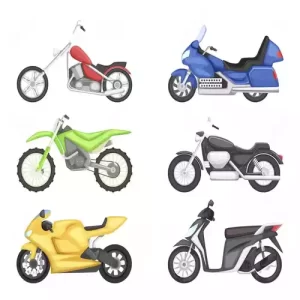
Bikes and motorcycles share many similarities despite their unique designs, purposes and propulsion systems. Here are just a few key ones between Bikes and motorcycles:
- Two-Wheeled Vehicles: Motorcycles and bikes are two-wheeled vehicles with one front wheel and one rear wheel that work together for balance and stability in operation. This gives both types of vehicles their distinctive character.
- Steering Mechanism: Both motorcycles and bikes utilize similar steering mechanisms. Both feature handlebars which riders use to direct their vehicle in any given direction by turning. Riders can change its course simply by shifting handlebars left or right.
- Braking System: Motorcycles and bikes both utilize brake systems to slow them down or stop when necessary, typically operated through hand levers on their handlebars. This similarity allows riders to control their speed easily as needed while simultaneously stopping when necessary.
- Manual Operation: Both motorcycles and bikes require manual operation in order to function. Bikes feature manual transmissions; unlike cars with automatic transmissions and clutches, riders need to manually shift gears using gear levers and clutches – adding another element of control and engagement while riding.
- Traffic Regulations and Rules: Motor vehicles and bikes alike must abide by traffic laws, signals and signs to maintain road safety and compliance with road rules. Motorcycles/bikes should share the road with pedestrians while safely maneuvering through traffic flow.
- Maintenance and Care: While specifics may differ between bikes and motorcycles, both require regular care to remain operational safely. Both require inspection of tires, oil changes and possible repairs in addition to routine tire inspection and lubrication checks and routine servicing as part of regular upkeep and care programs.
- Riding Techniques and Skills: To safely operate a motorcycle or bike, certain skills and techniques must be learned and perfected. Balance, coordination and knowledge of weight shifting as well as body positioning must all come into play so as to navigate around turns, corners and various road conditions with ease.
- Riding Gear: Helmets and gloves should always be used by motorbike riders to stay protected, while helmets play an essential part of keeping riders secure on two wheels.
These similarities between bikes and motorcycles despite their differences demonstrate both vehicles’ two-wheeled nature, as well as their core riding and operating aspects.
Conclusion
Bikes and Motorcycles offer unique experiences to riders around the world. Bikes are known for their simplicity, environmental friendliness, and suitability for urban commuting. On the other hand, motorcycles are synonymous with power, speed, and long-distance travel. Whether you’re looking for a way to navigate city streets efficiently or crave the adrenaline rush of a powerful engine, the choice between a bike and a motorcycle ultimately depends on your individual preferences and lifestyle.

